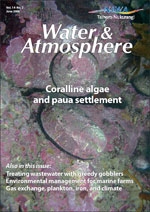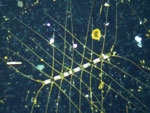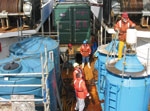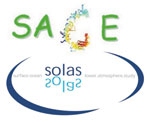PDF of this article (219 KB)



In the subantarctic waters southeast of New Zealand, Cliff Law and the SAGE Team have found that pumping iron doesn't always build bulk.
About half of New Zealands' EEZ lies in nutrient-rich subantarctic waters. However, phytoplankton, the microscopic plant cells that live in the surface layer, do not grow to their full potential in these waters due to a lack of dissolved iron, which they need for photosynthesis and growth. This iron-limitation of phytoplankton is found in other regions, such as the Southern Ocean and the Gulf of Alaska, where iron-infusion experiments have resulted in large phytoplankton blooms visible from space. As part of SAGE (see box below), we studied the effects of iron addition in the southwest Bounty Trough, about 250 km east of the Otago Peninsula.
Phytoplankton and trace gases
Our aim was to use the surface ocean as a natural laboratory, by adding iron to stimulate a phytoplankton bloom that would alter the air-sea exchange for a variety of gases. When phytoplankton grow, they remove carbon dioxide (CO2) from the water and convert it to organic carbon, some of which sinks to the deep ocean via the 'biological pump'. This decreases the dissolved CO2 and so increases CO2 uptake from the atmosphere into the water, and has led to speculation that large-scale iron fertilisation of the ocean could slow the build-up of CO2 in the atmosphere. Phytoplankton also release compounds that stimulate production of trace gases such as nitrous oxide and methane, which are greenhouse gases, and dimethylsulphide (DMS), which affects cloud formation in the atmosphere. Through these compounds, phytoplankton indirectly influence earth’s climate; by stimulating a phytoplankton bloom we hoped to learn more about the air-sea exchange of these climate-reactive gases.
Adding iron
We prepared the iron solution in two 7500-litre tanks and pumped 1.35 tonnes of dissolved iron sulphate into surface waters during each infusion. To the iron solution we added a tracer, sulphur hexafluoride (SF6), that allowed us to track the movement of the fertilised patch (see Gas exchange and climate). The phytoplankton responded rapidly to the iron addition, with an increase in the photosynthetic ability of the phytoplankton in the iron patch that was maintained throughout the experiment. However, after four iron infusions over 15 days, chlorophyll-a, the phytoplankton pigment used to measure total phytoplankton, had only doubled, and we saw little evidence of enhanced CO2 uptake or increased production of DMS and other trace gases.
Iron isn't everything
The phytoplankton response was modest compared with other iron-fertilisation experiments, and seems to have been limited by other factors. These could include limited light availability for photosynthesis or lack of other important micronutrients. It is also possible that the patch diluted too rapidly for phytoplankton to accumulate, or that the phytoplankton were rapidly grazed down by zooplankton.
At a recent international meeting at NIWA in Wellington (see Workshop on iron-enrichment studies), participants compiled results from 10 iron-fertilisation experiments. Light availability was identified as critically important, with the SAGE experiment conducted under the lowest light levels of any experiment to date. Although the SAGE experiment did not generate strong gas gradients, it provided an important contrast to other iron-fertilisation experiments and showed that iron addition alone is not a panacea to promoting phytoplankton stocks and CO2 uptake in iron-limited waters.
The SAGE experiment

SOLAS (Surface-Ocean Lower-Atmosphere Studies) is an international programme studying the key biogeochemical-physical interactions and feedbacks between the ocean and atmosphere, and how this coupled system affects and is affected by climate and environmental change.
SAGE – the SOLAS Air-sea Gas Exchange experiment – was a New Zealand-led voyage involving 17 organisations in 6 countries. The G of the SAGE logo shows the water temperature we measured as the Tangaroa followed a tracer-labelled patch of water around an ocean eddy.
For more information on this experiment, see: www.niwascience.co.nz/rc/atmos/sage and to learn more about SOLAS see: www.solas-int.org
Dr Cliff Law is a biogeochemist based at NIWA in Wellington. Other members of the SAGE Team are listed on the SAGE web page: www.niwascience.co.nz/rc/atmos/sage
Teachers’ resource for NCEA AS: Biology 90167 (1.7) Science Level 2 US90766, Level 3 US6355. See other curriculum connections at www.niwa.co.nz/pubs/wa/resources
